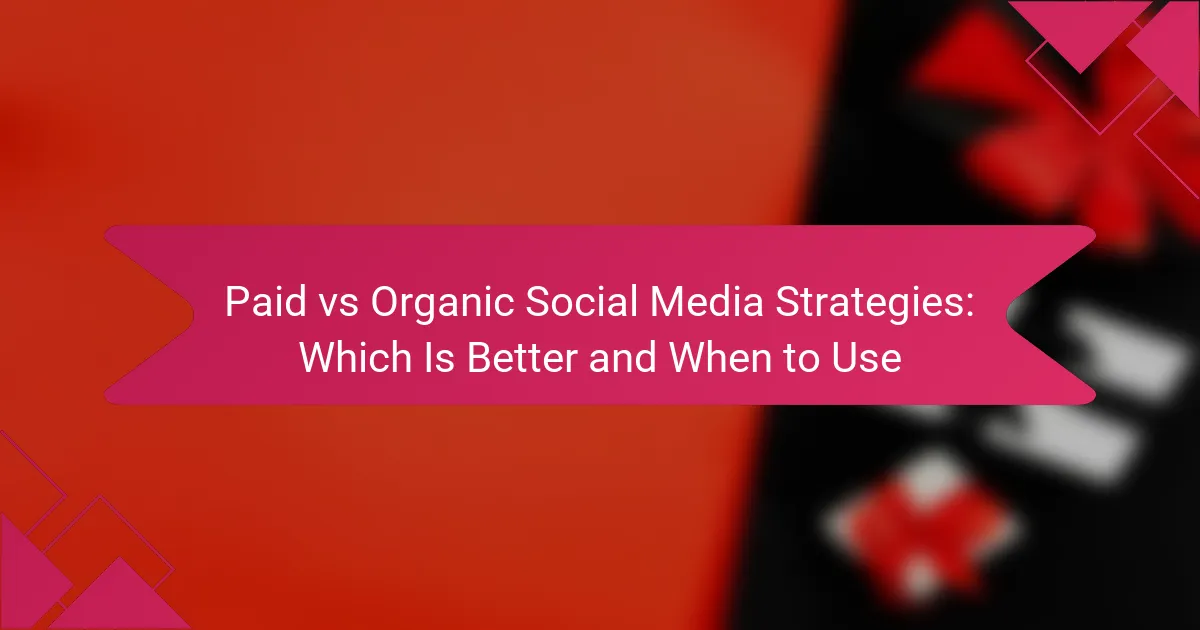In the dynamic landscape of social media marketing, businesses must navigate the choice between paid and organic strategies to maximize their impact. Paid strategies offer immediate visibility and targeted reach, making them ideal for quick results, while organic strategies focus on building a loyal audience and fostering community connections over time. Understanding when to leverage each approach is crucial for developing a well-rounded marketing plan that meets specific business goals.

What are the benefits of paid social media strategies in Canada?
Paid social media strategies in Canada offer businesses immediate visibility and the ability to reach specific audiences effectively. These strategies can enhance brand recognition, drive engagement, and provide measurable results, making them a valuable component of a comprehensive marketing plan.
Immediate reach and visibility
Paid social media campaigns allow brands to gain instant visibility among their target audience. Unlike organic strategies, which can take time to build momentum, paid ads can be seen by thousands of users within hours of launching. This immediacy is particularly beneficial for time-sensitive promotions or product launches.
For example, a Canadian retailer promoting a seasonal sale can quickly reach potential customers in specific regions, ensuring that the message is timely and relevant. This capability to generate immediate traffic can significantly boost sales during critical periods.
Targeted audience segmentation
One of the standout features of paid social media strategies is the ability to segment audiences precisely. Advertisers can tailor their campaigns based on demographics, interests, behaviors, and even location, ensuring that the right message reaches the right people. In Canada, this means targeting users based on provinces or cities, which can enhance local relevance.
For instance, a business in Toronto can create ads that specifically appeal to urban dwellers, while a company in rural Alberta can focus on different interests. This targeted approach increases the likelihood of engagement and conversion.
Performance tracking and analytics
Paid social media strategies provide robust performance tracking and analytics tools that help businesses measure the effectiveness of their campaigns. Advertisers can monitor metrics such as impressions, clicks, conversions, and return on ad spend (ROAS) in real-time. This data-driven approach allows for quick adjustments to optimize performance.
In Canada, platforms like Facebook and Instagram offer detailed insights that can inform future strategies. By analyzing which ads perform best, businesses can refine their targeting and messaging, leading to improved results over time.
Brand awareness and engagement
Investing in paid social media can significantly enhance brand awareness and foster engagement with potential customers. Ads that resonate well can lead to increased shares, likes, and comments, amplifying the brand’s reach beyond the initial audience. This organic engagement can be particularly valuable in building a loyal customer base.
For Canadian brands, creating visually appealing and culturally relevant content can help in connecting with diverse audiences. Engaging ads can spark conversations and encourage user-generated content, further enhancing brand visibility and credibility in the marketplace.
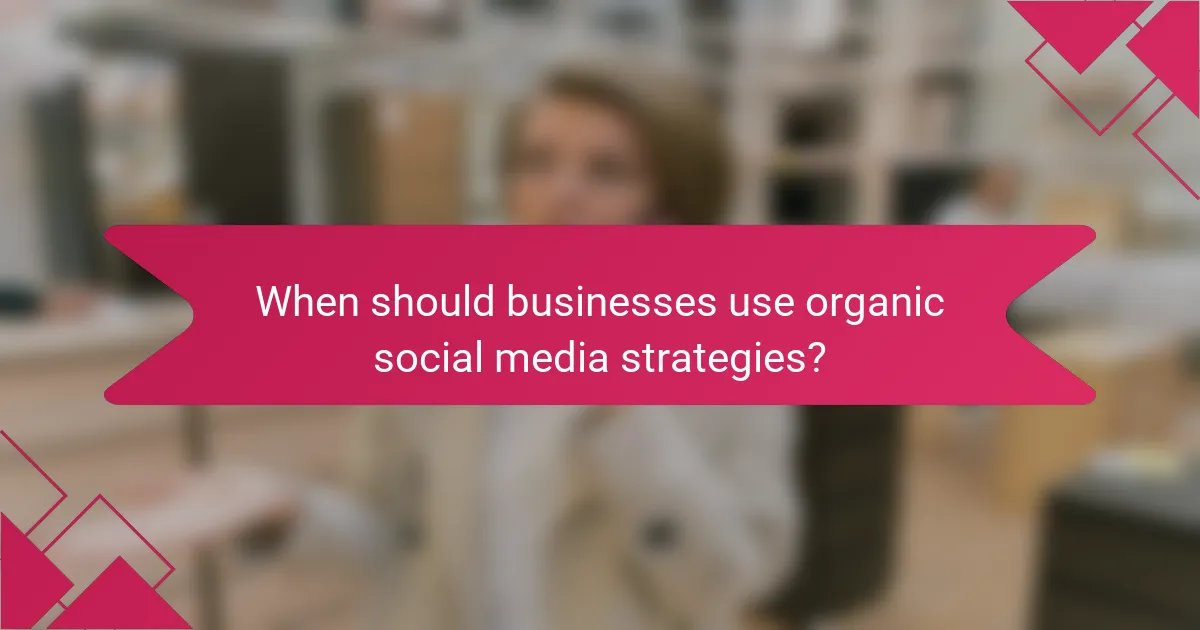
When should businesses use organic social media strategies?
Businesses should use organic social media strategies when they aim to build a loyal audience without incurring significant advertising costs. These strategies are particularly effective for long-term engagement, brand building, and fostering community connections.
Building long-term relationships
Organic social media allows businesses to cultivate long-term relationships with their audience by providing consistent, valuable content. This approach encourages interaction and feedback, which can strengthen customer loyalty over time.
Engaging with followers through comments, shares, and direct messages fosters a sense of community. Regularly posting updates, responding to inquiries, and sharing user-generated content can enhance these relationships.
Cost-effectiveness for small businesses
For small businesses with limited budgets, organic social media strategies offer a cost-effective way to reach potential customers. Unlike paid advertising, organic methods rely on creativity and engagement rather than financial investment.
By focusing on high-quality content and leveraging free tools, small businesses can effectively increase their visibility. Utilizing platforms like Instagram, Facebook, and Twitter allows them to reach audiences without the pressure of advertising costs.
Enhancing brand authenticity
Organic social media strategies help enhance brand authenticity by showcasing the human side of a business. Sharing behind-the-scenes content, employee stories, and customer testimonials can create a relatable brand image.
Authenticity resonates with consumers, leading to increased trust and loyalty. Businesses that prioritize genuine interactions and transparency are more likely to attract and retain customers who value these qualities.
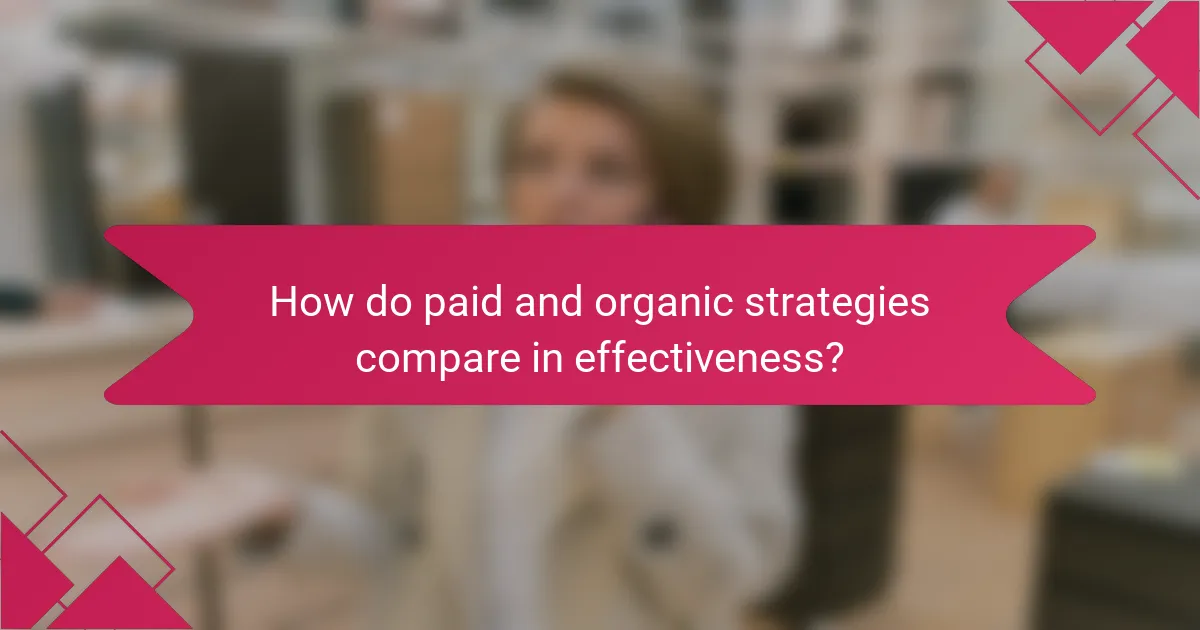
How do paid and organic strategies compare in effectiveness?
Paid and organic social media strategies each have unique strengths and weaknesses that influence their effectiveness. Paid strategies typically yield immediate visibility and reach, while organic strategies foster long-term engagement and community building.
Engagement rates
Engagement rates often differ significantly between paid and organic posts. Organic content tends to generate higher engagement rates as it is perceived as more authentic by users. In contrast, paid posts may attract clicks but often see lower interaction levels, as users can be skeptical of sponsored content.
For instance, brands may find that organic posts achieve engagement rates in the range of 1-5%, while paid posts might hover around 0.5-2%. This difference highlights the importance of balancing both strategies to maximize overall engagement.
Cost per acquisition
Cost per acquisition (CPA) is a critical metric when comparing paid and organic strategies. Paid strategies usually have a higher CPA due to direct advertising costs, which can vary widely based on the platform and targeting options. Organic strategies, while requiring time and effort, often result in a lower CPA since they leverage existing audiences without direct spending.
For example, a business might spend $5-$10 per acquisition through paid ads, while organic efforts could reduce that cost to just a few cents, depending on the effectiveness of the content and community engagement.
Longevity of content
The longevity of content is another key factor in evaluating paid versus organic strategies. Organic posts can continue to generate engagement over time, as they remain visible in feeds and can be shared by users. This long-lasting impact can lead to sustained visibility without ongoing costs.
In contrast, paid content typically has a short lifespan, often only effective for a few days or weeks while the budget lasts. After that, visibility drops significantly unless additional funds are allocated. Brands should consider this when planning their social media strategies to ensure a mix of both short-term and long-term content effectiveness.
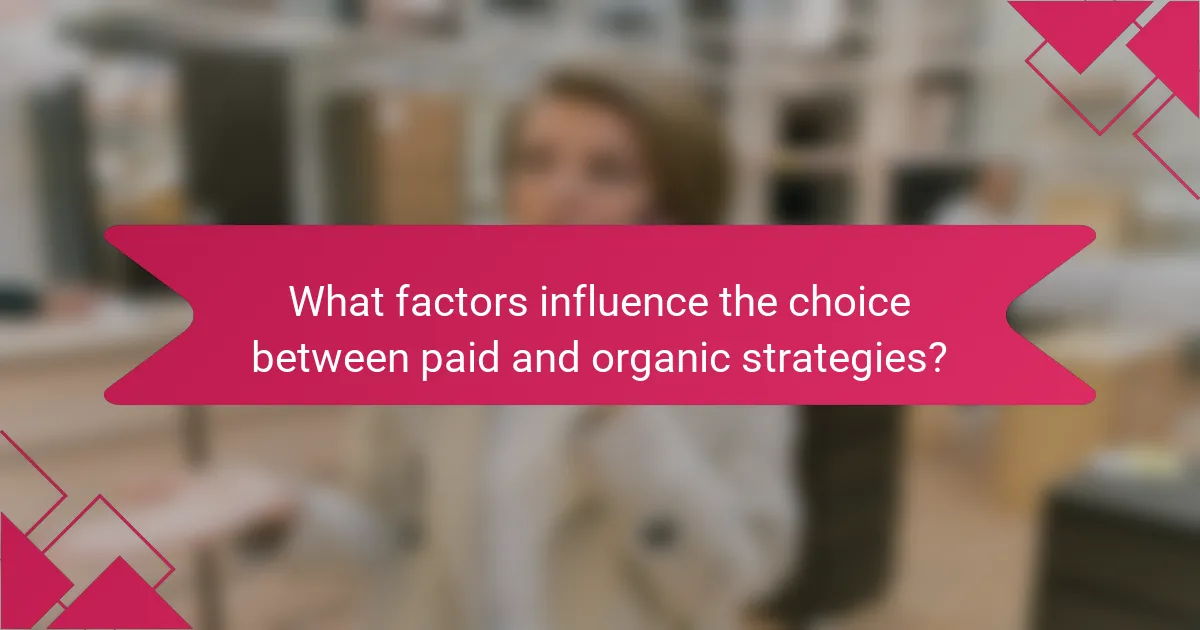
What factors influence the choice between paid and organic strategies?
The choice between paid and organic social media strategies depends on various factors, including business goals, audience behavior, and budget constraints. Understanding these elements helps determine the most effective approach for reaching your target market.
Business goals and objectives
Your business goals significantly influence whether to pursue paid or organic strategies. If your aim is to achieve rapid brand awareness or drive immediate sales, paid strategies may be more effective. Conversely, if you seek long-term engagement and community building, organic methods can foster deeper connections with your audience.
Consider aligning your social media strategy with specific objectives, such as increasing website traffic, generating leads, or enhancing customer loyalty. Each goal may require a different approach, so evaluate which strategy best supports your desired outcomes.
Target audience behavior
Understanding your target audience’s behavior is crucial in deciding between paid and organic strategies. Analyze where your audience spends their time online and how they interact with content. If your audience frequently engages with ads, paid strategies may yield better results.
On the other hand, if your audience values authentic content and peer recommendations, organic strategies could be more effective. Utilize tools like surveys or social listening to gather insights about your audience’s preferences and habits.
Budget constraints
Budget constraints play a vital role in determining your approach to social media strategies. Paid strategies often require a more substantial financial investment, which can vary widely based on platform and campaign goals. If your budget is limited, you may need to prioritize organic strategies that rely on content creation and community engagement.
Evaluate your available resources and consider a balanced approach. For example, you might allocate a portion of your budget to paid promotions while focusing on organic growth through consistent content posting and audience interaction. This hybrid method can maximize your reach without overspending.

What are the best practices for integrating paid and organic strategies?
Integrating paid and organic social media strategies involves aligning both approaches to maximize reach and engagement. Best practices include maintaining consistent branding, coordinating content calendars, and utilizing insights from both strategies to inform future campaigns.
Consistent branding across channels
Consistent branding is crucial for creating a unified experience across paid and organic social media. This means using the same logos, color schemes, and messaging to reinforce brand identity. For example, if your organic posts feature a specific tone, ensure that your paid ads reflect that same voice.
To maintain consistency, develop brand guidelines that outline visual and verbal elements. Regularly review both paid and organic content to ensure alignment, and adjust as necessary to keep messaging cohesive.
Coordinated content calendars
Coordinating content calendars for paid and organic strategies helps streamline messaging and timing. This ensures that promotions, campaigns, and organic posts complement each other, maximizing audience engagement. For instance, if you plan a product launch, schedule organic posts to build anticipation alongside paid ads that drive immediate sales.
Utilize tools like Google Calendar or social media management platforms to create a shared calendar. This allows team members to see upcoming content and adjust their strategies accordingly, preventing overlap and confusion.
Utilizing insights from both strategies
Leveraging insights from both paid and organic strategies can enhance overall performance. Analyze engagement metrics, audience demographics, and conversion rates to identify what resonates with your audience. For example, if a particular organic post performs well, consider boosting it with paid promotion to reach a larger audience.
Regularly review analytics from both strategies to inform future content decisions. This data-driven approach helps refine targeting and messaging, ensuring that both paid and organic efforts are aligned and effective.
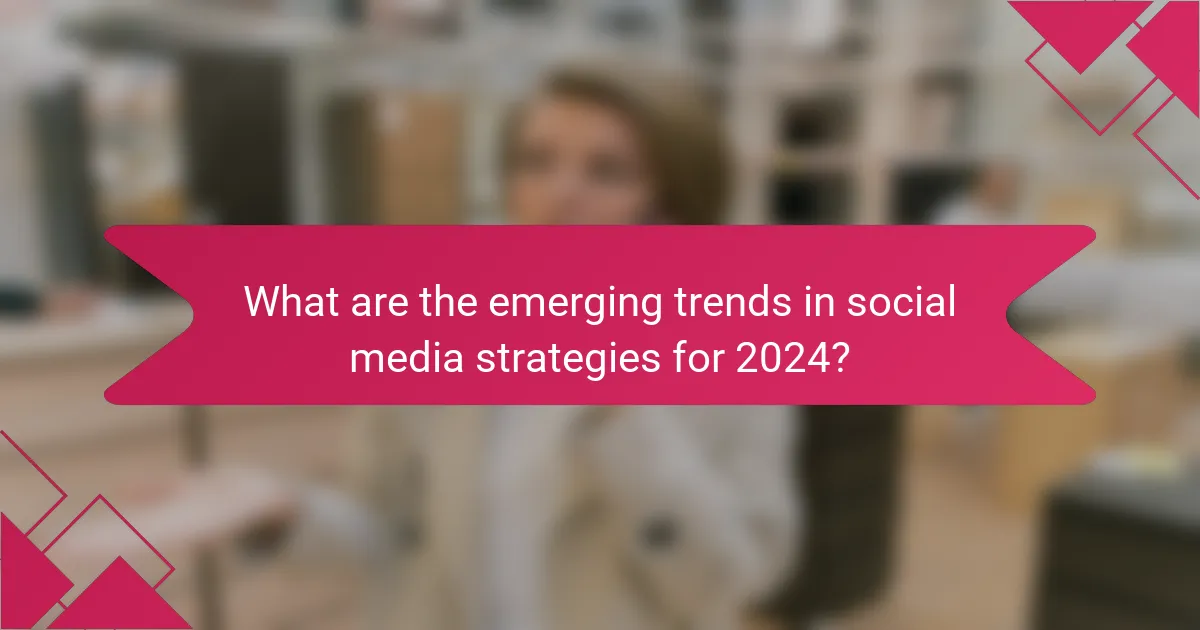
What are the emerging trends in social media strategies for 2024?
In 2024, social media strategies are increasingly focusing on advanced technologies and engaging formats. Key trends include the use of artificial intelligence for precise targeting and a significant rise in video content, both of which enhance user engagement and conversion rates.
Increased use of AI in targeting
The integration of artificial intelligence in social media targeting allows brands to analyze user behavior and preferences more effectively. AI algorithms can process vast amounts of data to identify patterns, enabling marketers to tailor their campaigns to specific audience segments.
For instance, platforms like Facebook and Instagram utilize AI to optimize ad placements, ensuring that content reaches users most likely to engage. This can lead to improved return on investment (ROI) as ads are shown to a more relevant audience.
To leverage AI in targeting, businesses should invest in data analytics tools and stay updated on platform algorithms. Regularly testing and refining audience segments can help maximize campaign effectiveness.
Growth of video content
Video content continues to dominate social media, with platforms prioritizing video formats in their algorithms. Short-form videos, such as those on TikTok and Instagram Reels, are particularly effective in capturing attention and driving engagement.
Brands should consider incorporating a mix of live streams, tutorials, and behind-the-scenes footage to create a diverse video strategy. Engaging storytelling and high production quality can significantly enhance viewer retention and brand loyalty.
To stay competitive, marketers should allocate a portion of their budget to video production and experiment with different styles and formats. Monitoring engagement metrics will help refine future video content strategies.






